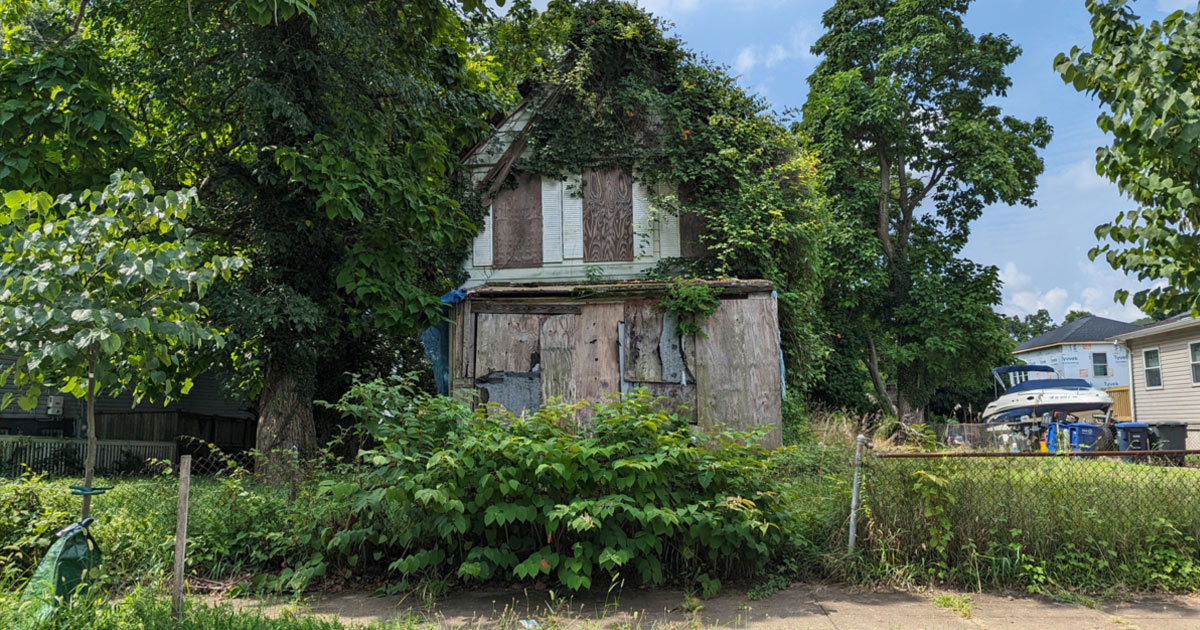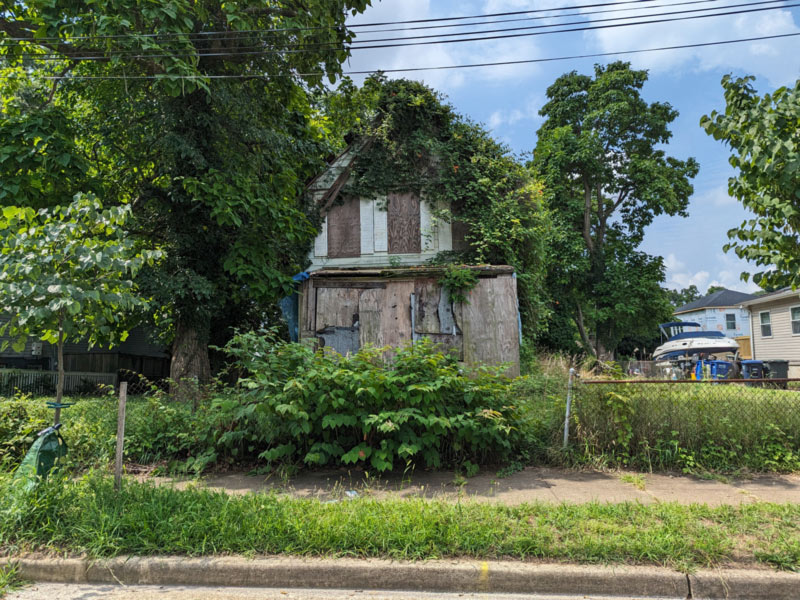Topic(s): Heirs' Property
How Community Partners and Local Governments Collaborate to Address Heirs’ Property
July 26, 2024

Residents who live near vacant, abandoned, and deteriorated (VAD) properties acutely understand their negative physical, mental, and financial impacts. But each VAD property has a unique story—and that property’s history is not always obvious.
Imagine your family has a home that has been passed down through multiple generations. Your grandparents purchased this home 75 years ago. After they passed away, your parents inherited the home. They’ve taken care of it for the past 12 years, but now they’re on a fixed income and cannot keep up with the cost of repairs.
You find a local home repair program and help your parents fill out an application, only to find out that they do not qualify because they do not have legal ownership—or title—to the house. When your grandparents passed away, they did not have a will or an estate plan.
Eventually the home’s repair needs become too challenging to keep up with, and your family makes the tough decision to walk away. Your grandparents’ home—the place where your family once gathered for holidays, birthdays, and family barbecues—begins to look like this:

When we work with a community, we always emphasize how important it is to understand the many different types of vacant properties. While they all might look the same—broken windows, overgrown grass, sometimes a portion of the structure burned or collapsing—the causes can be quite different. Understanding a property’s history helps determine which intervention will be most effective and appropriate and can help inform strategies to prevent similar properties from meeting that same fate in the future.
One of the most challenging vacant properties to resolve? Heirs’ property.
What is “heirs’ property”?
When a property owner dies without a will or estate plan, state laws governing inheritance determine how the property is divided among the remaining family members, or heirs. Even if a will exists, there still usually needs to be some action taken to document the transfer from the deceased family member to the appropriate heirs.
As time goes by, these unresolved property issues become more complex. Resolving fractional, unrecorded ownership (also referred to as tangled title) is complex, and unaffordable for many families. Tangled title also makes it difficult—often impossible—to obtain property insurance; get property tax relief; secure funding like repair or rehab grants, loans, or disaster relief funding; or sell the property.
At the Center for Community Progress, we’ve engaged with heirs’ property issues for years. To take our work even further, we supported two pilot projects from entities doing innovative work to address and prevent these properties.
Tackling Heirs’ Property in Jacksonville, Florida with LISC Jacksonville
Community Progress partnered with Local Initiatives Support Corporation (LISC) Jacksonville as it works to better understand and address heirs’ property issues locally.
Connecting the definition of “heirs’ property” to people and communities
LISC creatively used publicly accessible data to identify markers that met an “heirs’ property profile.” Data provided by Duval County Property Appraiser and Vital Statistics Data showed that heirs’ properties in Jacksonville doubled in count between the years 2014 and 2023. In response to this growing issue, LISC partnered with local community development corporations to canvass door-to-door and host educational community workshops. In these meetings and conversations, residents receive information and comprehensive assistance with heirs’ property issues.
Folks working to resolve heirs’ property issues may be wary of help, especially when the offer sounds too good to be true. Leading by building trust allows LISC to help families maintain stable ownership of their property and make informed decisions about what to do with it if they do not want ownership.
LISC’s community outreach efforts included:
- Distributing flyers and post cards with QR codes linked to LISC Jacksonville Heirs’ Property website and partner websites/intake forms
- Sharing testimonials from people who navigated the heirs’ property process—those who have lost or have come close to losing an heirs’ property
- Launching a public “Ask me about Heirs’ Property” campaign, running ads on bus stops and distributing free swag at community events
- Publishing a free, online Heirs’ Property Toolkit
But community organizers and neighborhood advocates are just one piece of the puzzle. An heirs’ property triggers an intricate process that requires legal expertise to navigate the rights and responsibilities of owning heirs’ property, and to help families obtain clear title to their properties. So LISC also partners with Three Rivers Legal Services to provide free legal support to help families resolve heirs’ property disputes.
Tackling Heirs’ Property in Savannah, Georgia with the Land Bank Authority
The Center for Community Progress partnered with Chatham County/City of Savannah Land Bank Authority (Land Bank Authority) to support its efforts to resolve complex title and other issues on former heirs’ property and create a pipeline that allows interested heirs to reclaim the land.
How can land banks work with heirs’ properties?
Land banks often assume responsibility for properties that slide into tax foreclosure or are unwanted by both the private market and the local government. They can also use other creative solutions to acquire properties and return properties to their use. That’s the case with the Land Bank Authority, which currently has about 30 heirs’ properties in its portfolio.
One of these properties belonged to an elderly property owner who passed away. The owner’s grandson, who grew up and lived in the house with his grandmother, wanted to buy the property to keep it in his family.
The Land Bank Authority is fully committed to keeping homes in families by assisting heirs. So when the owner’s grandson approached the Land Bank Authority about acquiring the property—with support of the other heirs—Executive Director Alison Goldey assembled a team of local partners to help.
The Land Bank Authority pursued the necessary legal action to untangle title, helped the grandson purchase the property, and provided him with a five-year loan at zero interest contingent on a 10 percent down payment. The Community Housing Services Agency provided technical assistance and a low-interest, five-year loan for the rehabilitation of the house from the Savannah Affordable Housing Fund.
This pilot is now part of a suite of strategies that the Land Bank Authority is implementing with partners to help other heirs reclaim family properties.
How can other communities work to address heirs’ properties?
An equitable process for navigating heirs’ property starts with gathering and analyzing data to better understand the scale and scope of heirs’ properties. It also requires:
- Consistent outreach and education to build trust and inform residents about heirs’ property and estate planning.
- Thoughtful program design—in collaboration with those most impacted by the problem—tailored to the unique challenges presented by heirs’ properties.
- Strategic partnerships for effective implementation.
This comprehensive approach works for tackling not only heirs’ properties, but also other types of VAD properties when trying to stabilize and revitalize neighborhoods.
More Heirs’ Property Resources from Community Progress
- Progress Point: Heirs’ Property Overview and 6 Things Local Governments Can Do
- Blog Post: Why Heirs’ Property is a Problem for Vacancy and Abandonment
- Webinar: Heirs’ Property as a Vacancy Issue: How Local Governments Can Address Tangled Title to Address or Prevent Property Abandonment and Deterioration
- Report: Unlocking the Potential in Heirs’ Properties: Examining Heirs’ Property in Three Rural Georgia Counties, in collaboration with the Carl Vinson Institute of Government
* * *
Looking to design policy solutions and programs that address different types of vacant properties? Our Technical Assistance team can help. Learn more about our services here and join us for more heirs’ property programming at the Reclaiming Vacant Property Conference this October 9-11 in St. Louis.
Subscribe to join 14,000 community development leaders getting the latest resources from top experts on vacant property revitalization.
